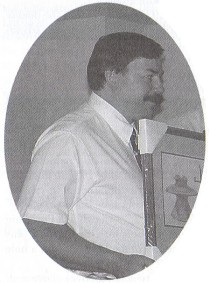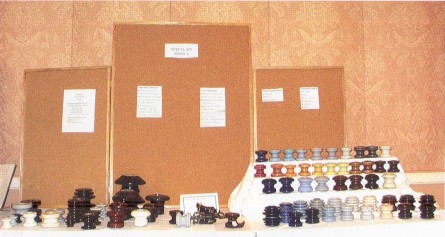Porcelain Spools
Reprinted from "Crown Jewels of the Wire", September 2001, page 19
Display by:
Rick Soller
4086 Blackstone Avenue
Gurnee, IL 60031 847-782-8602
com57 4@clc.cc.il.us
WINNER:
1st Place N.I.A. Porcelain
Jack H. Tod Memorial Award
Porcelain spools offer a great deal of diversity for the insulator collector:
- They come in a variety of shapes;
- There is a wide spectrum of colors they
come in;
- They were produced using both the wet process and dry process
method; and
- They were used for a variety of purposes.
Despite this diversity, there are probably few collectors who specialize in
these. In addition, little has been written about some of the design features of
spools, how they were used, what companies made them, and how they are
classified. This display addresses these issues, starting with the one that
probably comes to mind first when looking at it.

Why do spools come in different colors?
In the display a variety of colors
are represented. Some colors were standard colors offered by the manufacturer or
established by standards organizations. Some colors were made to blend into the
environment better. Some colors were used by utility companies to indicate which
wires were hot and which wire was the neutral.
Standard Colors.
An examination
of the catalogs of several manufacturers or jobbers of porcelain spools
indicated that the standard colors for many years were brown or brown and white
(Canadian Line Materials 1950, p. 8; Graybar 1941, p. 896; Illinois Electric
Porcelain Co. 1930, p. 99; Joslyn 1939, p. 89; Know 1929, p. 56; Ohio Brass
1953, p. 144, Westinghouse 1936, p. 359). In fact, the 1953 Ohio Brass catalog
reprints the 1952 EEI-NEMI standards that establish brown as the standard color.
In later years, this color probably changed to a sky tone to blend in with the
surroundings better.
Special Colors.
It's not clear why colors other than brown,
white and sky tone were made. Two colors would be enough to distinguish the hot
wires from the neutral wire. It could be some users wanted to use other color
combinations to distinguish the hot wires and the neutral or it could be that
lines were color coded for some other reason such as the voltage of the wires,
or who owned the wire.
Strangely enough, most of the spools in a special color
are unmarked or unattributed.
In the chart below, the colors are listed in order of their rarity with any
markings listed to the right of the color.
|
COLOR
|
MARKING
|
|
Cobalt
|
Thomas, {Triangle-M}
|
|
Blue
|
|
|
Grey-green
|
Line Material
|
|
Orange
|
Sissell, Joslyn
|
|
Yellow
|
T
[Thomas], L in a Circle [Unattributed]
|
|
Red
|
|
For what were spools used?
Spools had a number of specific applications. The
Illinois Electric Company in their catalog number 26 indicates that spools on a
secondary rack could:
"Replace secondary crossarms. Wires are strung in vertical alignment, permitting taking off service wires without aid of buck arms
or spreader brackets" (p. 599).
When used with a clevis bracket, the 1929
Knox Porcelain Corporation catalog indicates that the spool can be used to
dead-end primary lines (p. 59). The 1939 Joslyn catalog states that, "It
can be used with equal success for dead ending, straight line work, or curves
(p.94)." Graybar (1941) lists them in a rack "designed as a house
bracket" (p. 896) while Westinghouse (1936) offers a variety of sizes for
primary and secondary circuits ranging from 1100 volts to 15,000 volts (p. 359).
Are there any specific features of spools?
Spools seem to have a fairly
simple design but there are some interesting features worth noting. These
include the tapered hole and extra wire grooves.
The Double Tapered Hole.
Porcelain Products in the 1937 catalog claims the double tapered holed was
developed by their engineers. According to the company, the advantage of having
the top and bottom of the hole wider than the center is that it:
"prevents
stress concentration on the edges of the holes and protects the spool from
breakage when the rack bolt is deflected under strain. For this reason, much
greater mechanical loads are possible without increasing the size of the
spool" (p. 910).
Ohio Brass points out the same advantage to their wet
process spools in their 1953 catalog:
"They have a tapered hole which
distributes the load more evenly and minimizes the possibility of breakage when
heavily loaded" (p. 36).
The amount that a hole tapers varies. The drawings
in the Porcelain Products catalog (1937) shows the center of the hole of one
3.125" x 3" spool to be 11/16" in diameter while the diameter of
the hole at the ends is 13/16" in diameter, a difference of 1/4". In
the Ohio Brass catalog (1953), a similarly sized spool with a center hole
diameter of 11/16" has a diameter of 15/16" at the ends of the hole, a
difference of 1/4", twice that of Porcelain Products spools. The Ohio Brass
catalog also shows other spools with the 1/4" taper plus a 2.25" x
2.125" spool with a diameter of 11/16" in the center of the hole but
with a hole diameter of 7/8" at the ends, a difference of only 3/16".
Extra Grooves.
Many of the insulators in the display have small grooves above and/or below the large center groove. These grooves increase the leakage
distance of the insulator slightly and then only meaningfully if the groove is
on the top and bottom of the insulator. However, several manufacturers also cite
these as another place to tie a wire.
Other things to think about.
Glass Look-A-Likes.
Several of the shapes in
this display can also be found in glass. Some can be found in amber which would
mimic the chocolate brown glazes of standard porcelain spools. On the other hand, there are some carnival colors that have
poor comparisons with porcelain.
A Classification Scheme.
Glass spools are
classified in N.R. "Woody" Woodward's Consolidated Design (CD)
numbering system but porcelain spools are not covered by the system developed by
Jack Tod for porcelain insulators. Standards organizations governing the
industry have categorized the standard designs but some nonstandard shapes are
probably missing. Were a classification scheme for porcelain spools developed,
what might it be like? Should it be appended to Tod's taxonomy like glass spools
are in Woodward's system? Should spools first be grouped by size and then by
shape or visa versa? Should foreign spools be included or separated in the
system? What's the difference between a spool and a guy strain, a radio strain
or a suspension insulator (especially a Hewlett-design)?
Conclusion.
Porcelain spools have more to offer than many collectors realize.
There are plenty of colors and shapes to track down. There is much organizing
ground-breaking that could be done. There is more research that could be
conducted. Hopefully this display will encourage spool collectors to "come
out of the closet" and stimulate them to pursue these projects.
(Information compiled by Rick Soller for display handout.)
Works consulted:
Canadian Line Materials Limited. (1950) Catalog No. 51. Toronto.; Graybar
Electric Company. (194,1). General Catalog No 102. R.R. Donnelley & Sons
Co.; Illinois Electric Company. (No date). Catalog No. 26. Chicago.; Illinois
Electric Porcelain Co. (1930). High Tension Insulators and Equipment. Catalog
No. 104. Macomb, IL.; Joslyn Mfg. and Supply Co. (1939). A Complete Listing of
Pole Line Construction Material. Catalog No. 12. Chicago, IL; Knox Porcelain
Corporation. (1929) Catalog No. 2. Knoxville, TN; Ohio Brass. (1953). Insulator
and Electrical Equipment. Catalog No. 28. Mansfield, OH; Porcelain Products,
Inc. (1937). Catalog No. 10. Parkersburg, WV.; Tod, Jack H. (1977). A History of
the Electrical Porcelain Industry in the United States. Phoenix, AZ: Privately
published.; Tod, Jack H. Porcelain Insulators Guide for Collectors. Phoenix, AZ:
Privately published.; Westinghouse Electric Supply Co. (1936). Electrical
Apparatus and Supplies. Catalog No. 72. R.R. Donnelley & Sons Co.; Woodward,
N.R. (1973). The Glass Insulator in America. Houston, TX: Privately published.

Porcelain Spools by Rick Soller
1st Place N.I.A. Porcelain
Jack H. Tod Memorial Award
| 